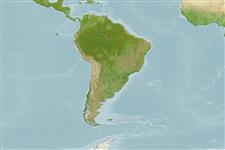Common names from other countries
Environment: milieu / climate zone / depth range / distribution range
Ecologia
marinhas; intervalo de profundidade 15 - 120 m (Ref. 31416). Temperate; 34°S - 48°S, 78°W - 68°W (Ref. 75154)
Circumglobal, southern seas.
Comprimento de primeira maturação / Tamanho / Peso / Idade
Maturity: Lm 36.9 range ? - ? cm
Max length : 47.0 cm SL macho/indeterminado; (Ref. 31416)
Ciclo de vida ou comportamento de acasalamento
Maturities | Reprodução | Spawnings | Egg(s) | Fecundities | Larvas
Pavlov, Y.P., 1991. Brama australis Valenciennes - a valid species of sea bream (Bramidae) from the southeastern Pacific Ocean. J. Ichthyol. 31(5):6-9. (Ref. 31416)
Status na Lista Vermelha da UICN (Ref. 130435)
CITES (Ref. 128078)
Not Evaluated
Ameaça para os humanos
Harmless
Uso pelos humanos
Pescarias: espécies comerciais
Ferramentas
Relatórios especiais
Baixar XML
Fontes da internet
Estimates based on models
Índice de diversidade filogenética (Ref.
82804): PD
50 = 0.5039 [Uniqueness, from 0.5 = low to 2.0 = high].
Bayesian length-weight: a=0.01820 (0.00782 - 0.04232), b=2.96 (2.76 - 3.16), in cm Total Length, based on LWR estimates for this (Sub)family-body shape (Ref.
93245).
Nível Trófico (Ref.
69278): 4.0 ±0.63 se; based on food items.
Resiliência (Ref.
120179): médio(a), tempo mínimo de duplicação da população 1,4 - 4,4 anos (Preliminary K or Fecundity.).
Prior r = 0.24, 95% CL = 0.16 - 0.35, Based on 1 data-limited stock assessment.
Fishing Vulnerability (Ref.
59153): Moderate vulnerability (43 of 100).
